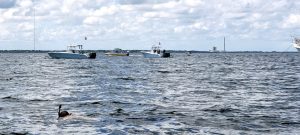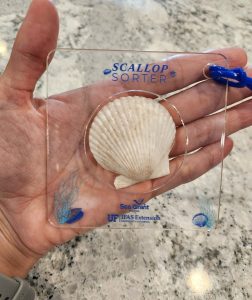 Summertime along Florida’s Nature Coast offers a unique adventure: recreational scalloping. Enthusiasts and families alike eagerly anticipate this activity, seeking out the bay scallops that inhabit the shallow seagrass beds. These fascinating creatures not only provide a fun and engaging experience but also highlight the importance of sustainable and responsible harvesting practices.
Summertime along Florida’s Nature Coast offers a unique adventure: recreational scalloping. Enthusiasts and families alike eagerly anticipate this activity, seeking out the bay scallops that inhabit the shallow seagrass beds. These fascinating creatures not only provide a fun and engaging experience but also highlight the importance of sustainable and responsible harvesting practices.
Meet the Bay Scallop
Bay scallops are bivalve mollusks, which means they have two hinged shells. As filter feeders, they play a crucial role in maintaining water quality by filtering plankton and other small particles from the water. Here are some interesting facts about these delicate marine animals:
- Life Span: Bay scallops live for about 18 months.
- Habitat: They are found in the shallow seagrass areas along Florida’s Gulf Coast.
- Movement: Scallops are capable of swimming in short bursts by rapidly opening and closing their shells.
- Eyes: They have bright blue eyes lining their shells, which they use to detect shadows, movements, and predators.
Environmental Sensitivity
Due to their short life span and susceptibility to environmental threats, bay scallop populations can vary significantly from year to year. Several factors influence their survival, including:
- Rainfall: Freshwater input can alter salinity levels, affecting scallop health. Bay scallops thrive in salinities between 20 and 38 parts per thousand. Large amounts of rainfall can cause the salinity of the systems to decrease rapidly.
- Temperature Changes: Scallops thrive in water temperatures between 68° and 77° Fahrenheit. When the water is too warm, it can lead to mortality events. Conversely, water that is too cold slows their filtration rate and reduces their reaction time to predators, making them more vulnerable.
- Habitat Degradation: Loss of seagrass beds and other habitats reduces their living space that provides protection from predators.
- Red Tides: Harmful algal blooms can devastate scallop populations. Unlike oysters and clams, which can survive for days with their shells tightly closed, bay scallops must continuously filter water and can only survive for a few hours when toxin concentrations are high.
- Sedimentation: Excessive sediment in the water forces scallops to expend more energy to filter out particles, which can clog their gills and lead to suffocation.
Responsible Harvesting
Given the environmental sensitivities of bay scallops, responsible harvesting is crucial to ensuring their continued presence in Florida’s waters. One key practice is adhering to the set bag limits, which helps manage the number of scallops taken.
Introducing the Scallop Sorter Tool
To encourage sustainable harvesting, Florida Sea Grant has developed the Scallop Sorter tool. This innovative tool assists scallopers in identifying larger individuals during the catch retrieval process. Here’s how it works:
- Secure the Tool: Attach the scallop sorter band to a mesh bag or your wrist before entering the water.
- Retrieve Scallops: Hand-retrieve scallops using legal harvesting methods.
- Measure Scallops: Place individual scallops onto the center hole of the sorter.
– If the scallop passes through the hole, it is too small to keep and should be returned to its habitat.
– If the scallop does not fit through the hole, it is large enough to harvest and enjoy.
In-Water Sorting: It is recommended to use the sorter tool while in the water to minimize the time scallops spend out of the water and increase their chances of survival when returned to seagrass beds.
Scallop Sorter tools are available free of charge (while supplies last) to recreational scallopers interested in participating in this sustainable effort. For those who want to create their own sorter, detailed instructions are available here.
Safe Scalloping Best Practices
Ensuring a safe and enjoyable scalloping experience requires following a few best practices:
-
- Gear Up: Wear appropriate snorkeling gear, including masks, fins, and snorkels. A mesh bag for collecting scallops is also essential.
- Stay Hydrated: Bring plenty of water and stay hydrated, especially under the hot Florida sun.
- Use Sun Protection: Apply sunscreen and consider wearing a rash guard to protect your skin from UV rays.
- Watch the Weather: Check the weather forecast before heading out. Avoid scalloping in rough or stormy conditions.
- Boating Safety: If you’re using a boat, ensure it is equipped with the necessary safety gear, including life jackets, a first-aid kit, and a dive flag to signal your presence to other boaters.
- Respect Wildlife and Seagrass: Be mindful of the marine life and habitats. Avoid scarring seagrass beds and damaging other underwater environments with boat motors and anchors.
Looking for additional scallop resources?
Frequently Asked Questions for Recreational Scalloping in Hernando
Get Out There, Have Fun, But Do It Responsibly!
 4
4

